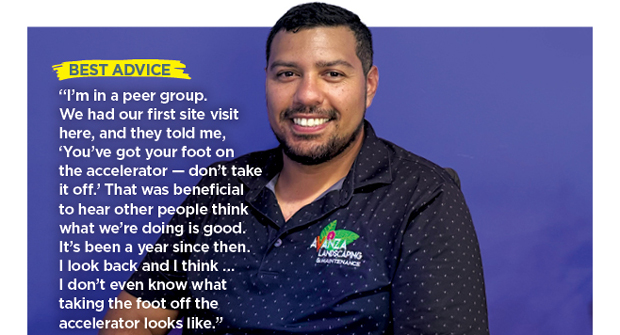Landscape and lawn care owners, it’s a great time to sell your business.
Mergers and acquisitions (M&A) activity continues to be robust within the green industry. Despite economic uncertainties, this strong appetite for M&A is driven by several key factors, says Jeff Harkness, founder and CEO of 3PG Advisors.

They include sustained high demand for residential services businesses, the green industry’s relative resilience to broader economic fluctuations and private equity firms actively raising and deploying capital within the sector.
“You turn on the news and feel like things are slowing in the broad universe of mergers and acquisitions,” says Harkness, whose firm provides strategic guidance to the facility services sector, encompassing landscaping, turf and tree care, pest control, nursery operations and snow and ice management. “But in the niche lawn and landscape industry, we’re not seeing any of that. We’ve never been busier.”
And while other hot industry sectors have experienced “bubbles” and subsequent bursts, Harkness remains bullish.
“I don’t see a bubble,” he says. “I think that there’s enough capital out there and there are enough people who are aware of the opportunity that exists in growing and scaling a business in the landscape and lawn care industries.”
Selling a business in today’s market, particularly within the landscape and lawn care industry, has become increasingly intricate, requiring careful consideration of its nuances throughout the sales process. M&A experts and experienced landscape and lawn care pros — those who’ve navigated these waters as both sellers and buyers — offer five essential insights to prepare for a sale.
Myth No. 1
Succession planning is a late-stage consideration
A common misconception about succession planning — specifically, an owner selling to an internal or external interest — is that it’s a decision reserved for the late stages of their professional life. Nothing could be further from the truth.
According to Harkness, succession planning and the prospect of selling the business should be an integral part of an owner’s annual strategic discussions, not merely a consideration for retirement or the event of unforeseen circumstances, such as illness.
Growth and exit strategies are inextricably linked with succession planning and must be woven into the company’s strategic blueprint, Harkness says. He believes this ongoing dialogue should involve the entire leadership team, recognizing that succession is not a distant goal for one’s 60s, but a continuous process.
“It must be part of the ongoing dialogue with your leadership team,” he says. “It must be part of your annual planning strategy because it offers you a path.”
For Gro-Masters’ Lynn Tootle, his succession plan had always been clear: Upon his previous partner’s departure, he would acquire their shares and continue the business. This deeply ingrained strategy had long guided his vision for the Savannah, Ga.-based lawn care company’s future. Tootle had even hoped that his children — a son in college and two daughters in high school — might eventually find interest in the business. However, a lack of familial interest removed a key reason for Tootle to postpone a sale indefinitely.

The concept of selling Gro-Masters to a private equity firm was initially far from Tootle’s mind. He acknowledges he didn’t fully grasp the intricacies of such a transaction. Private equity deals were relatively new to the “spray world,” although they were more established in commercial maintenance.
The idea only materialized when competitive offers, presented by his business broker, began to escalate. At this point, with concrete figures on the table, the possibility of a private equity acquisition truly entered Tootle’s considerations, dramatically altering his previously held succession plans.
“We got our business broker involved and had him shop out opportunities if we were to go the direction of private equity investment,” Tootle says. “It became very evident that with the dollars that (private equity buyers) were talking about, it made no sense to do anything other than sell.”
In late January, LawnPRO Partners, a private equity platform specializing in residential lawn care treatment, tree, shrub, and pest control services, successfully acquired Gro-Masters in an acquisition backed by HCI Equity Partners. Tootle remains president.
The Gro-Masters deal, like many in today’s market, reflects a broader evolution in the motivations of small-business owners. Harkness says that while owners in their 60s and 70s still consider selling for retirement or succession, a growing number of owners in their 30s and 40s are now seeking to sell or bring in partners.
This emerging model, he explains, is about strategically partnering and leveraging capital to scale, rather than simply exiting the business.
This trend centers on a desire to achieve significant growth without the limitations of a one-customer-at-a-time approach, explains Harkness. He notes this “buy-and-build” strategy involves seeking external capital, which can encompass various forms of debt or equity.
“Now what we have are owners in their 30s and 40s who are scaling quicker. They’re seeing an opportunity to have multiple pay days or liquidity events and still own and drive the business,” he says. “The difference is, they’re not using their own checkbook. They’re working with a partner that has unlimited capital and resources without personal liability.
“It’s not about selling your business,” Harkness adds. “It’s about scaling up and executing a different growth strategy with partners and capital resources that 10 to 15 years ago just weren’t thought about in the industry.”
Myth No. 2
You’re ready to sell
According to M&A insiders, a commonly held belief among most owners is that they’re prepared to sell their business. But this often proves wrong.
Many business owners, including those in the green industry, often approach selling their companies impulsively, typically seeking buyers only after achieving a desired EBITDA (or earnings before interest, taxes, depreciation and amortization). This key financial metric directly reflects a company’s profitability and operational performance. Think of it as a snapshot of raw earning power, vital for valuation, comparison, negotiation and forecasting.
Problems arise when a business hits its EBITDA target, but the owner hasn’t conducted any of the foundational preparatory work to sell, says Jay Jung, the principal and founder of Embarc Advisors based in West Hollywood, Calif. His firm provides high-level financial expertise to small and midsize companies. Notably, Embarc Advisors counts The Grounds Group, a Fort Lauderdale, Fla.-based commercial property maintenance firm, among its clients.
A successful business sale demands considerable lead time — typically six to 24 months or longer — to optimize the operation for an exit, Jung says. He equates it to prepping a house for sale.

“If I’ve had this home for 50 years before I sell it, then I might want to redo the kitchen, clean up the bathroom, fix any foundational issues and repaint. Then, toward the end, I would stage it, maybe do some landscaping and then sell it,” Jung says. “And that’s how you maximize the bang for the buck. But a lot of business owners don’t do that.”
According to Jung, rushing to market means sellers often leave low-hanging fruit — untapped value — on the table. Therefore, strategic preparation is critical for a successful M&A outcome, a process for which the private equity industry has largely defined the playbook.
“If private equity wants to sell or exit an investment in two years’ time, then they’ll start doing things differently,” he says. “They’re going to maximize EBITDA. They’re going to maximize the metrics the buyer is going to look for. They’re going to start trimming some of that fat, and they’re going to really run the business to maximize the deal value. And that can take some time.”
At Gro-Masters, Tootle says he would have approached the sale process differently if given the chance by proactively cleaning up the company’s financials and aggressively optimizing EBITDA. He firmly believes that such meticulous preparation, which could have involved different decisions regarding cash flow management or specific financial entries, would have significantly enhanced Gro-Masters’ valuation.
“Clean your books up, because your value is going to be based on your EBITDA,” Tootle says. “And if your books don’t show it, and you can’t produce the appropriate paperwork to prove it, then that doesn’t count. When you’re talking about multiplication factors of whatever X-times EBITDA, every dollar that falls to your bottom line pays you that many more dollars. So, really have a mindset to build your books.”
Myth No. 3
The bottom line is the bottom line
While income statements, balance sheets, debt-to-equity ratios and working capital all play important roles in any successful M&A deal, sellers must also factor in significant intangibles.

In recent years, Lake Bluff, Ill.-based Mariani Premier Group has actively participated in the M&A market, completing 30-plus acquisitions. CEO Bryan Christiansen notes that Mariani consistently targets businesses with strong fundamentals, such as revenue growth, healthy margins and an established, balanced portfolio.
Beyond financials, Mariani also seeks companies with strong leadership and a professional ethos for high-end, quality work.

“Most importantly, we ensure that partner companies are aligned with our guiding principles of taking care of our customers, respecting and empowering our employee base and are dedicated to continued learning and improvement,” Christiansen says. “We’re building the ultimate peer group that shares a commitment to excellence through idea generation, collaboration and sharing of best practices. Cultural fit is paramount to Mariani’s success.”
Acquisitions are a unique and individualized process, says Kurt Bland, CEO of Bland Landscaping. His fast-rising Apex, N.C.-based commercial landscape company is backed by Comvest Private Equity. He stresses that during due diligence, buyers will place a company’s culture and team dynamics under their microscopes.
Dealmaking, according to Bland, is a complex blend of science and art, demanding that numerous boxes must be checked during due diligence. While economics and mathematics are crucial, the art often lies in identifying the right people, ensuring cultural fit and a commitment to seeing processes and procedures through to completion.
“The owner has to be willing to open up,” he says. “If they refuse to share information, financial results, customer lists, employee census … you just can’t get through due diligence without that information. A prudent buyer is not going to invest in something that they haven’t been able to perform their due diligence.”
Most buyers recognize the inherent value of a target company’s intangibles, even as they introduce a standardized, best-in-class operational mindset to the acquired business.
“We’ve learned that when you force companies to completely assimilate, they lose what made them successful in the first place,” Christiansen says. “We look for strong teams where people genuinely care about the work and each other.”
Myth No. 4
You know your true worth
According to M&A experts, small business owners often underestimate or incorrectly calculate their company’s true financial value and worth. This typically occurs because they either lack objectivity or simply don’t possess the systematic know-how required for accurate valuation.
Initial business valuations often fall into one of two common traps. Owners sometimes develop an unrealistic valuation — one that exceeds what the market will genuinely bear — driven by their deep emotional connection and significant personal investment in the business. Conversely, a business can be undervalued if its total financial metrics are incomplete, overlooked or incorrectly calculated, leading to a missed opportunity for the seller.
Bland attributes much of this to what he calls the “deep-pockets fallacy,” the mistaken belief that private equity-backed firms will overpay for businesses due to their seemingly endless access to capital. While it is true that private equity firms command significant financial resources, Bland emphasizes that they operate strictly within economic realities.
Consequently, while it might seem appealing to maximize a business’s perceived value, Bland stresses that its actual, sustainable worth is ultimately limited by what can be effectively managed and carried forward.
“You cannot pay more for a business than what that business can create in cash flow to satisfy the repayment of the purchase price, whether it was purchased with borrowed money, saved money or retained earnings,” he says. “The economics of it in a free market are such that you can’t pay more for something than what that something can return on the investment that you’ve made.”
EBITDA is a critical metric that frequently arises in M&A discussions. Its prominence is well-deserved, as it plays a pivotal role in both business valuation and the rigorous due diligence process. EBITDA enables potential buyers to accurately assess a target company’s operational profitability and its capacity to generate cash flow, unburdened by the complexities of financing structures or varying accounting methodologies. When precisely calculated, EBITDA offers sellers and buyers a transparent view of a company’s financial well-being, thereby facilitating more astute decision making throughout the transaction.

David Koehn of Koehn Outdoor in Jacksonville, Fla. Bland acquired Koehn in October. (Photo: Bland Landscaping)
However, Jung believes most small businesses miscalculate their true EBITDA. Therefore, he suggests obtaining a Quality of Earnings (QoE) report, a detailed financial analysis that reflects the reliability and sustainability of the company’s reported earnings. Jung asserts that a QoE is often the highest return on investment a seller can make.
To best understand worth, Jung recommends taking a page out of private equity’s playbook.
“Even though private equity does GAAP (generally accepted accounting principles) accounting, they have audited financials,” he says. “Every time they sell a company, they will always do a seller’s quality of earnings, because they want to maximize their EBITDA. So that’s point No. 1: Sellers often don’t do a quality of earnings, which means a lot of cases we’ve seen (where) they understate their EBITDA.”
Additionally, Jung believes business owners have a skewed view of business valuation multiples, driven by industry reports suggesting, for example, a $1 million business being valued at a six-times multiple, businesses with $2 million to $3 million in revenue quoted at an eight-times multiple or those exceeding $3 million potentially commanding a ten-times multiple.
However, Jung says it’s crucial to understand that these are merely general observations, and the actual multiples applied to a business’s earnings, such as EBITDA, can vary significantly based on a multitude of factors.
“It’s crucial to remember that the multiples frequently cited in the market for business valuations, particularly in M&A, represent averages or medians,” he says. “This wide range is largely a function of successfully identifying the ideal buyer and then effectively communicating a compelling narrative about the business’s value to that specific buyer.”
Myth No. 5
You can do it alone
Many small business owners underestimate the intricate nature of an M&A transaction. While finding an interested buyer might seem like the primary challenge, in today’s digital age, that’s often the easiest part. The real value of an M&A professional lies in navigating the complexities that can significantly impact a seller’s net proceeds. Experts agree that bringing in an adviser with extensive M&A experience is a strategic move that yields higher valuations, smoother transactions and reduced risk for the seller.
According to Harkness, many business owners believe they are capable of managing the M&A process themselves or they can lean on general advice from industry peers. This often leads them to underestimate the emotional and intricate nature of selling a business, causing them to overlook crucial facts and strategic considerations that lead to money being left on the table, he says. That’s why expert guidance is essential to uncover those vital facts and develop a sound strategy for the seller.

Getty Images Plus / Getty Images)
“Unfortunately, too many times owners think they can do it on their own, and that’s a problem,” Harkness says. “You don’t learn about growth and succession and exit strategies in a one-hour discussion with a colleague over coffee.”
Tootle says sellers must never undervalue a trustworthy business broker. He cites due diligence as a prime example, describing it as an exceptionally thorough process demanding detailed reports and financial figures. Tootle says navigating this intricate phase would have been considerably more challenging without a broker’s expert guidance.
“This is not something that I would have ever attempted to do myself,” he says. “I know how to grow grass. I do it every day. I’m not involved in M&A every day, but these guys are. So, every penny you spend for a good (adviser) is worth its weight in gold.”
According to Harkness, the most valuable truth for sellers about the M&A process is that greatness never chases money, but money always chases greatness.
“Focus on building a great business, and the other stuff is going to take care of itself regardless of whether it’s a strategic or private equity buyer,” he says. “Sometimes, we get mesmerized by what’s right, what’s wrong and what’s better. Great companies are always going to be marketable … and there’s not enough of them in the industry.”


